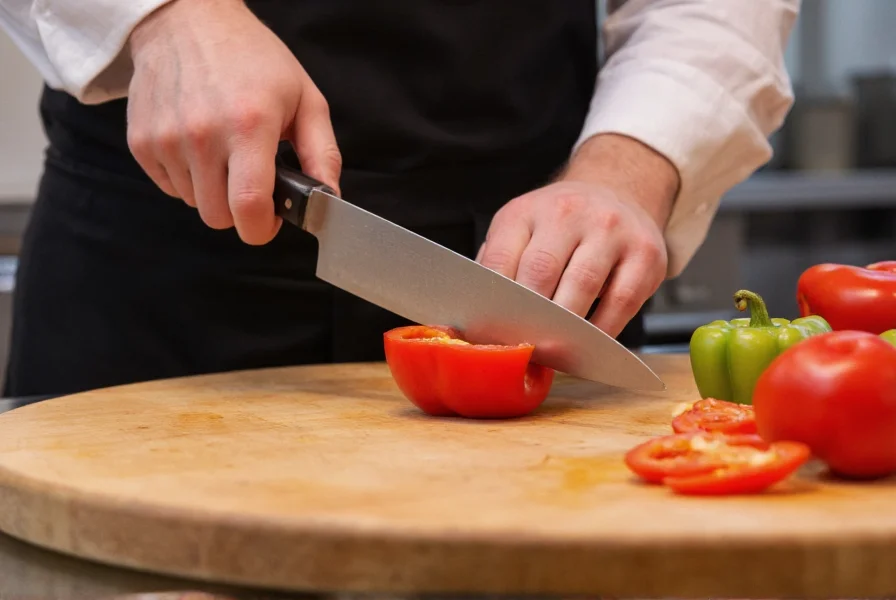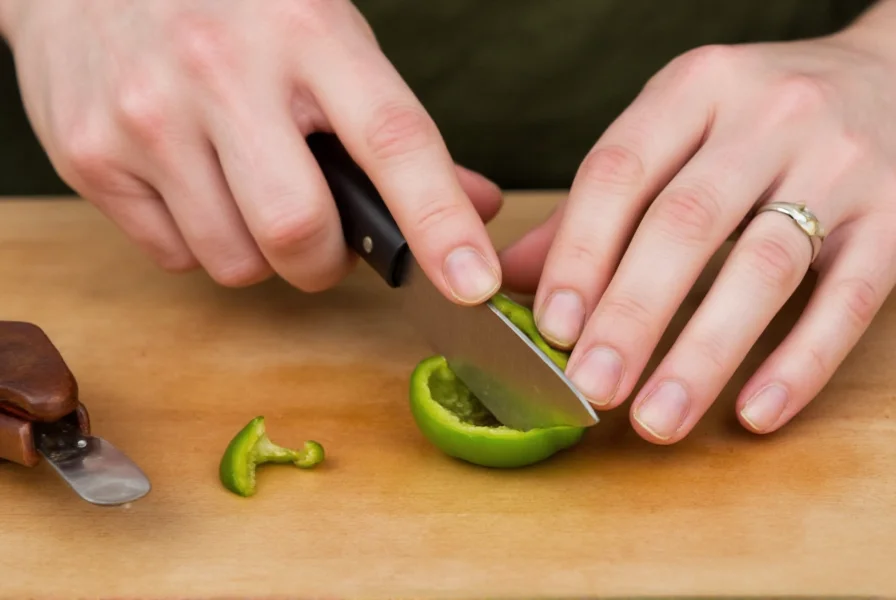Slicing peppers correctly transforms your cooking experience, whether you're preparing stuffed peppers, adding vegetables to stir-fries, or creating colorful salads. The right technique prevents wasted produce, minimizes kitchen accidents, and ensures your peppers maintain their shape and texture during cooking. Many home cooks struggle with peppers slipping on the cutting board or uneven slices that cook inconsistently—problems easily solved with proper method.
Essential Tools for Slicing Peppers
Before learning how to slice a pepper, gather these kitchen essentials:
| Tool | Recommended Type | Why It Matters |
|---|---|---|
| Knife | 8-inch chef's knife | Provides control and precision for clean cuts through pepper walls |
| Cutting Board | Stable wooden or plastic board | Prevents slipping and protects knife edge |
| Optional | Nitrile gloves | Essential when handling hot peppers to avoid skin irritation |

Step-by-Step Guide to Slicing Peppers Safely
Follow these steps for perfect pepper slices every time, whether you're learning how to slice bell peppers for fajitas or preparing jalapeños for salsa:
Preparation Phase
- Wash thoroughly - Rinse peppers under cool water, scrubbing gently to remove dirt and pesticides
- Dry completely - Moisture makes peppers slippery and dangerous to cut
- Assess pepper type - Bell peppers require different handling than thin-walled chili varieties
Core Removal Technique
- Cut off ends - Remove 1/4 inch from both stem and blossom ends
- Stand upright - Position pepper vertically on the flat end
- Slice along ribs - Carefully cut downward following the natural curves to separate pepper quarters from core
- Remove seeds - Lay each quarter flat and scrape away seeds and white membranes with your knife
Slicing Methods for Different Recipes
Now that you've mastered how to slice a pepper properly, adapt your technique to your culinary needs:
- Julienne (matchstick) cuts: Stack pepper quarters, cut lengthwise into 1/8-inch strips - perfect for stir-fries and fajitas
- Dice: After julienning, cut crosswise for uniform cubes ideal for salsas and salads
- Rings: Slice horizontally through whole pepper for sandwiches or garnishes
- Wedges: Cut whole pepper vertically into 6-8 pieces for roasting or stuffing
Safety Tips When Handling Hot Peppers
Learning how to slice spicy peppers safely prevents painful mistakes. Capsaicin, the compound that makes peppers hot, transfers easily to skin and eyes:
- Always wear nitrile gloves when handling habaneros, ghost peppers, or other super-hots
- Never touch your face while cutting hot peppers
- Clean your knife and cutting board immediately after use with hot, soapy water
- If you get capsaicin on your skin, wash with vinegar or milk before soap and water
- Consider using a dedicated cutting board for hot peppers to prevent flavor transfer
Common Pepper Slicing Mistakes to Avoid
Even experienced cooks make these errors when learning how to slice a pepper correctly:
- Using a dull knife - Causes crushing instead of clean cuts and increases slip risk
- Skipping the drying step - Wet peppers slide dangerously on cutting boards
- Improper grip - Use the "claw grip" with fingertips curled under for safety
- Rushing seed removal - Incomplete seed removal leads to inconsistent heat in dishes
- Incorrect storage - Sliced peppers should be refrigerated in airtight containers
Storing Sliced Peppers Properly
Maximize freshness after you've sliced your peppers:
- Place in airtight containers with a paper towel to absorb excess moisture
- Refrigerate immediately - properly stored sliced peppers last 5-7 days
- For hot peppers, label containers clearly to prevent accidental exposure
- Freeze for long-term storage (up to 6 months) in single layers before transferring to bags
Perfecting Your Pepper Slicing Technique
Mastering how to slice a pepper transforms your cooking efficiency and safety. Practice these professional techniques to develop muscle memory:
- Start with bell peppers before progressing to thinner-walled varieties
- Focus on consistent thickness for even cooking
- Keep your knife sharp - a honing steel maintains edge between sharpenings
- Work methodically rather than quickly for better control
Whether you're preparing peppers for stuffed pepper recipes, adding color to vegetable medleys, or creating the perfect fajita filling, proper slicing technique makes all the difference. The best home cooks understand that foundational knife skills elevate every dish they prepare.
Frequently Asked Questions
What's the safest way to handle hot peppers when slicing?
Wear nitrile gloves when slicing hot peppers like jalapeños or habaneros. Avoid latex as capsaicin can penetrate it. Never touch your face during preparation, and clean all surfaces immediately afterward with hot, soapy water. If you experience skin irritation, wash with vinegar before soap and water.
How do I prevent peppers from slipping on the cutting board?
Thoroughly dry peppers after washing, as moisture causes slipping. Place a damp towel under your cutting board for stability. For bell peppers, create a flat surface by trimming a small portion from one side before standing it upright. Always use the claw grip with your non-knife hand.
What knife works best for slicing different pepper varieties?
An 8-inch chef's knife works best for most peppers. For thin-walled varieties like banana peppers, a 5-inch utility knife provides better control. When slicing multiple peppers, maintain your knife's edge with occasional honing. Never use serrated knives for peppers as they tear rather than slice cleanly.
How thin should I slice peppers for different cooking methods?
For stir-fries and fajitas, slice peppers 1/8-inch thick for quick, even cooking. For roasting or stuffing, cut 1/4-inch thick to maintain structure. Salsa requires small 1/4-inch dice, while sandwiches benefit from 1/4-inch rings. Thinner slices work better for quick-cooking applications, while thicker slices hold up to longer cooking times.
Can I slice peppers in advance for meal prep?
Yes, you can slice peppers 3-4 days in advance for meal prep. Store in airtight containers with a paper towel to absorb moisture. Place in the crisper drawer of your refrigerator. Bell peppers maintain quality longer than thinner-walled varieties. For best results, slice immediately before use, but advance preparation works well for weekly meal planning.











 浙公网安备
33010002000092号
浙公网安备
33010002000092号 浙B2-20120091-4
浙B2-20120091-4